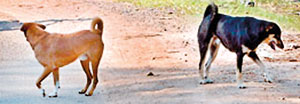Man’s best friend on the street must remain on the street
 Some love dogs; some hate them; some fear them.
Some love dogs; some hate them; some fear them.
Yet, man and dog have co-existed for centuries, but it has not always been a peaceful co-existence.
The Mahavamsa records that when Prince Vijaya landed in our country (Thambapanni) in the 5th century BC with 700 followers, on seeing a dog and surmising that “only where there is a village are dogs to be found”, they had followed the dog, a journey leading the prince to Kuveni, his future queen.
On April 19, the Cabinet considering the “difficulties occurring with stray dogs to the public” requested the Ministers of Local Government and Health to present proposals in this regard.
I believe what is meant by “difficulties” is the “nuisance factor” and the “rabies factor.”
Who is responsible for these “difficulties”? It is us – humans. Abandoning unwanted pups in public places, indiscriminate garbage dumping, unsystematic garbage disposal, irresponsible pet ownership, are some contributory factors.
The solution – reducing the stray dog population humanely, through the WHO-acknowledged CNVR (Catch-Neuter-Vaccinate-Release) method.
The Rabies Ordinance of 1897, based on 19th century thinking that animals are chattel, allows stray dogs to be destroyed to control rabies - the practice was to gas the dogs, an excruciatingly painful end to innocent, healthy animals. In 2006, during the 2600th Sambuddhathva Jayanthi , then President Mahinda Rajapaksa declared a “No Kill Policy”, directing sterilisation and vaccination to humanely control rabies. The credit for convincing the then President to declare this Policy goes to Sagarica Rajakarunanayake, founder of Sathva Mithra.
The “No Kill Policy” however, is yet to receive statutory recognition. Today, when many countries recognise animals as sentient beings, with a right to life, it is time that this predominantly Buddhist nation follows suit and amends its laws. Eighteen Animal Welfare Organizations (AWOs) through a court case, have proposed such an amendment and the Minister of Local Government has assured that this will be done.
Under the “No Kill” Policy, local authorities conduct CNVR programmes, which are successful in some, but not all districts. If the reasons are identified, the gaps can be addressed. AWOs too supplement government programmes and two highly successful public-private partnerships were those of Blue Paw Trust and Embark in collaboration with the Colombo Municipal Council and the MOH Maharagama, supported by foreign AWOs. India’s Animal Birth Control (Dogs) Rules recognise a distinct role for AWOs in CNVR programmes.
Public Health Veterinary Services statistics reveal that human rabies deaths were highest when killing was at its peak. With CNVR, it decreased substantially. Between 2008 and 2014, human rabies deaths decreased from 51 to 19, but increased to 24 in 2015. Is that due to weaknesses in government programmes?
Chennai is today a rabies-free metropolis due to its dynamic CNVR programmes. In Latin America, mass vaccination has proved to be the most effective rabies control measure.
The Indian Supreme Court has set a shining example. Stating that it is necessary to balance compassion for animals and the existence of human beings and acknowledging that killing street dogs is no solution and sterilization is the answer for dog population control, Chief Justice K.G. Balakrishnan, in January 2009 directed all Indian states to sterilise every stray dog, allowing only irretrievably ill or rabies infected dogs to be destroyed. “A dog cannot be exterminated because it barks. It is inhumane to kill street dogs. They too have a right to life”, observed Judge Fali Nariman.
Removing street dogs is imprudent.When sterilized and vaccinated dogs are removed, another group, neither sterilized nor vaccinated takes over and tends to be aggressive in unfamiliar surroundings. Vaccinated dogs living in groups create “herd immunity”preventing outside dogs coming into their territory. Since most street dogs are cared for by the community, abandoning them in distant locations, as happened during the then Colombo Beautification Programmes or during special events like CHOGM 2013 is cruel. When abandoned in strange surroundings they cannot survive without food and are vulnerable to attack by local dogs.
Dogs also control the rat population.
Government shelters are disasters managed by people with no interest in animal welfare and clueless about dog needs and dog behaviour. This was proved beyond doubt, when the shelter at Nellikulama managed by the Anuradhapura Municipal Council was forced to close, at the cost of dozens of dog lives and millions of rupees. It was “hell” for the dogs – squalid, no proper food or veterinary care, dogs dying of infections. During its last days, AWOs had to intervene and care for and rescue the surviving dogs.
Our Environment Police often castigate those feeding stray dogs, saying it pollutes the environment, despite the streets being cleared after feeding.The Delhi High Court, on the other hand, ruled that there is no law prohibiting feeding street dogs and determined that those who do so perform a constitutional duty of showing compassion to all living creatures, and directed India’s Animal Welfare Board to earmark sites sparingly used by the public,to establish stray dog feeding stations, while also ordering the Delhi Police to protect persons feeding street dogs who are exposed to the ire of ill-informed, ill-advised residents and administrators. In our country, Dog Managed Zones initiated by Blue Paw Trust is a similar concept where within a demarcated public area, such as a hospital, vaccinated and sterilised dogs can be fed, with proper garbage management..
There are no short cuts to control the dog population. Killing is inhumane; relocating is imprudent; abandoning is cruel; government shelters can be disasters. The only humane and sustainable option is CNVR. In November 2015, five AWOs submitted recommendations to the Megapolis Minister how to revive CNVR so that Sri Lanka’s target of eradicating rabies by the set date can be achieved.Co-existence will then become peaceful co-existence. And for this faithful animal, providing us companionship and protection - Man will become the Dog’s Best Friend.


